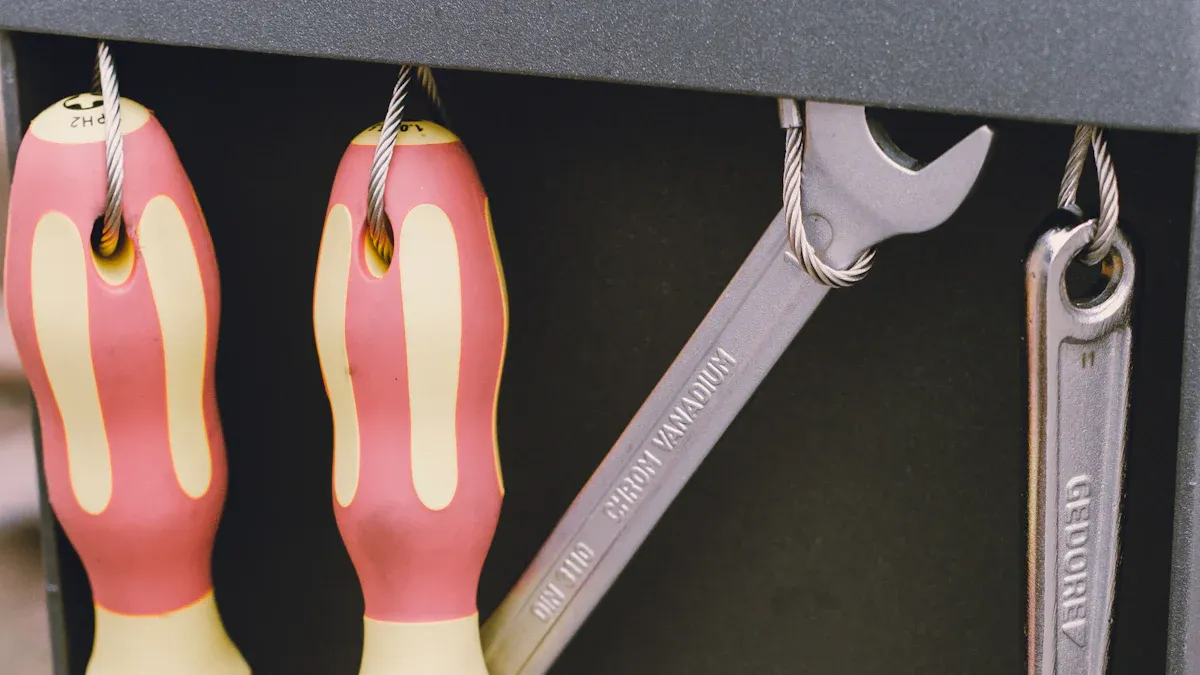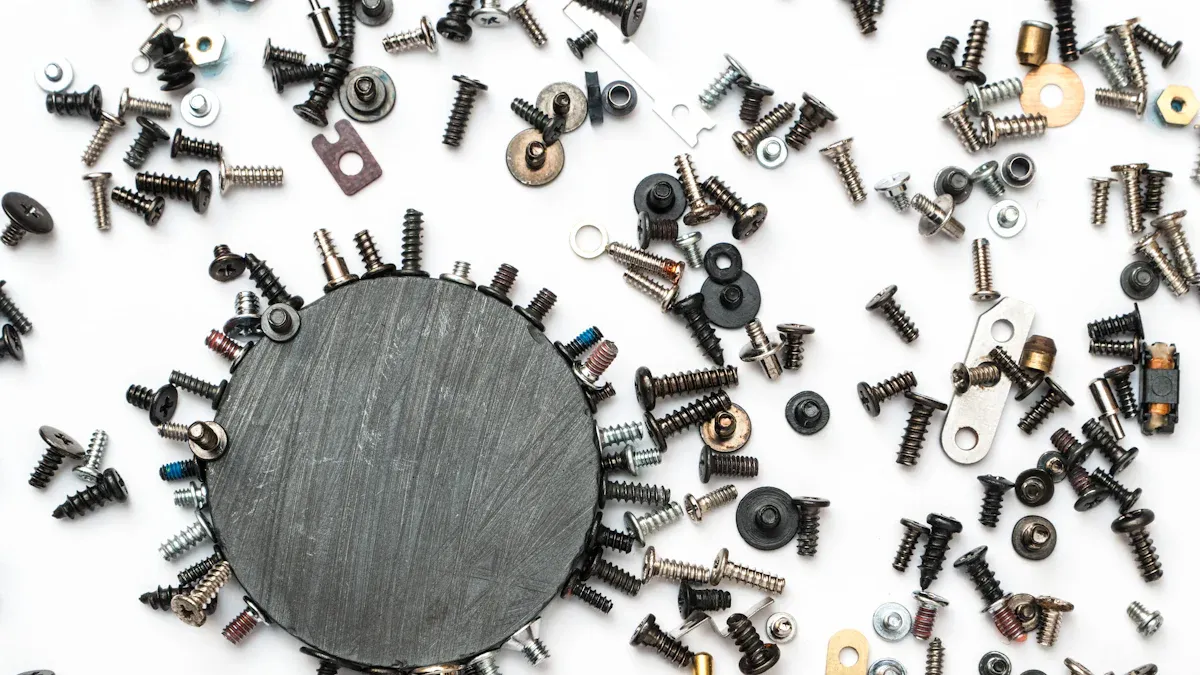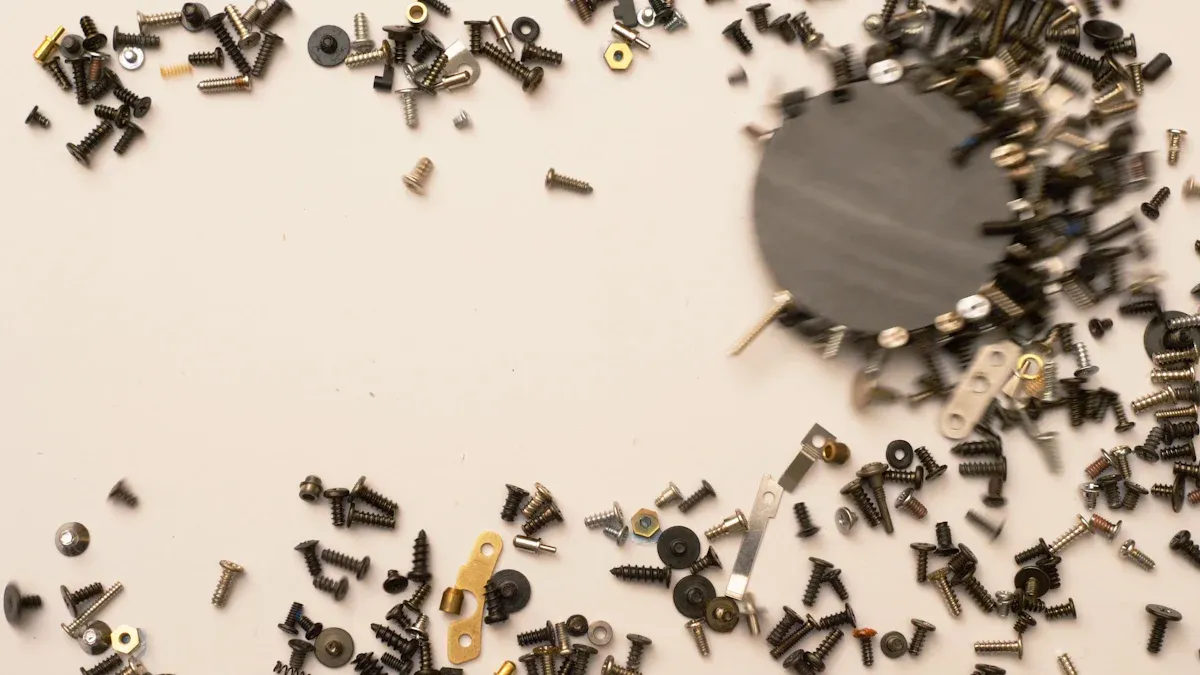
Anyone new to a Pick Up Tool Magnetic might feel a bit unsure at first. They can relax, though, because using a Magnetic Tool feels simple with the right approach. Many people start by practicing with the Magnetic Pickup Tool on small screws or nails. This helps them get comfortable with the grip and strength of the Magnetic Pick Up. Safety matters, so they should keep fingers clear and avoid electronics. Over time, even a Magnetic Retrieval Tool feels like second nature.
Tip: Practicing on easy-to-reach objects builds confidence before tackling tight spaces with a Magnetic Pickup.
Key Takeaways
- Start by practicing with small metal objects to get comfortable using the magnetic pick up tool.
- Choose a tool with the right magnet strength and features like a telescopic shaft and non-slip handle for your needs.
- Always use the tool slowly and keep your fingers clear to avoid injuries like pinching.
- Keep the tool away from electronics to prevent damage and data loss.
- Clean and store the tool properly after each use to keep it working well and lasting longer.
Pick Up Tool Magnetic: What You Need to Know
Key Features for Beginners
A Pick Up Tool Magnetic comes with several features that make it beginner-friendly. Many models use neodymium magnets, which offer strong pull strength and reliability. Some tools use ferrite magnets, which resist corrosion but have less power. Beginners often prefer telescopic shafts made from stainless steel or aluminum. These shafts extend to reach distant objects and collapse for easy storage.
Handles matter, too. Cushioned, non-slip grips help users keep control, even when hands get greasy. Some tools have flexible or pivoting heads. These heads make it easier to grab items in tight spots. A few models include LED lights to brighten dark corners. Portability is another plus. Lightweight materials and pocket clips let users carry the tool anywhere.
Tip: Always check the real-world lifting capacity. Some tools claim to lift more than they actually can. For example, a Craftsman 15-pound tool lifted only 7.5 pounds in tests, while an Ultrasteel 8-pound tool managed just 2.5 pounds.
| Feature | Why It Matters for Beginners |
|---|---|
| Magnet Type | Stronger magnets pick up heavier items |
| Telescopic Shaft | Reaches far or collapses for storage |
| Ergonomic Handle | Reduces hand fatigue |
| Flexible Head/LED Light | Helps in dark or tight spaces |
| Portability | Easy to carry and store |
Why a Pick Up Tool Magnetic Is Useful
A Pick Up Tool Magnetic saves time and effort. It helps users retrieve screws, nails, or bolts that fall into hard-to-reach places. In garages, it can grab dropped sockets or washers from under cars. Around the house, it picks up pins or paperclips from behind furniture.
People also use it for creative tasks. Some use the tool to clean up metal shavings after a project. Others use it to check for lost jewelry in tight spaces. The tool works well in both home and work settings.
Real-world tests show that features like LED lights can help in dark areas, but sometimes reduce magnet strength. Users should match the tool’s pull strength to their needs. For heavy-duty jobs, a tool with a 20-pound rating works best. For everyday tasks, a 5- to 10-pound tool is enough.
Note: A Pick Up Tool Magnetic is not just for professionals. Anyone can use it to make daily tasks easier and safer.
Step-by-Step Guide: How to Use a Pick Up Tool Magnetic

Preparing for Use
Getting ready to use a Pick Up Tool Magnetic starts with a quick check. They should look at the tool and make sure the magnet is clean. Any dirt or metal shavings can lower its strength. If the tool has a telescopic shaft, they can extend it and check for smooth movement. A quick wipe with a dry cloth helps keep the magnet strong.
Next, they should clear the area where they plan to use the tool. Removing clutter makes it easier to spot metal objects. Good lighting helps, too. If the tool has an LED light, they can test it before starting. Wearing gloves can protect hands from sharp metal edges.
Tip: Always test the magnet on a small metal object first. This helps users get a feel for the pull strength.
Operating the Tool Safely
When using the Pick Up Tool Magnetic, they should move slowly and keep a steady hand. Fast movements can cause the tool to miss the target or knock other items over. They should aim the magnet directly at the metal object. If the object is in a tight spot, a flexible head or telescopic shaft can help reach it.
They should keep fingers away from the magnet’s path. Strong magnets can pinch skin if not handled carefully. If the tool grabs a heavy item, they should lift it slowly and keep the tool steady. For small screws or nails, a gentle touch works best.
Note: They should never use the tool near computers, phones, or other electronics. Magnets can damage sensitive devices.
Here’s a quick checklist for safe operation:
- Move the tool slowly toward the object.
- Keep fingers clear of the magnet.
- Use both hands for heavy items.
- Avoid swinging the tool near electronics.
Aftercare and Storage Tips
After using the Pick Up Tool Magnetic, they should clean the magnet. A soft cloth removes dust and metal shavings. If the tool picked up oily or greasy items, a damp cloth can help. They should dry the tool before storing it.
Collapsing the telescopic shaft makes storage easier. Many people keep the tool in a toolbox or hang it on a pegboard. Storing the tool in a dry place prevents rust. If the tool has a battery-powered light, they should turn it off to save battery life.
Tip: Regular cleaning and proper storage help the tool last longer and work better.
| Aftercare Step | Why It Matters |
|---|---|
| Clean the magnet | Keeps pull strength strong |
| Dry after cleaning | Prevents rust |
| Collapse shaft | Saves space |
| Store in dry place | Extends tool lifespan |
Practical Tips for Getting the Most from Your Pick Up Tool Magnetic
Choosing the Right Model for Your Needs
Selecting the best magnetic pick up tool depends on the job. Some people need a tool for small screws, while others want to grab heavier items. A telescopic shaft helps reach far or awkward spots. Flexible heads and LED lights make it easier to see and grab objects in dark corners. People should check the magnet’s strength and the handle’s grip. A comfortable, non-slip handle reduces hand fatigue during long tasks.
Practical tips from the field show that adjusting the tool for the right gap and alignment improves accuracy and durability. For example, keeping the magnet clean and checking for smooth extension helps the tool last longer. Regular inspection and cleaning also prevent problems down the road.
Tip: Always match the tool’s lifting power to the job. A lightweight model works for small jobs, but heavy-duty tasks need a stronger magnet.
Handling Small and Large Metal Objects
Magnetic pick up tools work best with ferromagnetic metals like iron or nickel. These metals have high magnetic permeability, so the magnet grabs them easily. Larger objects stick better because of their size and material. Small screws or nails also attach well, but users should move slowly to avoid dropping them.
- Ferromagnetic metals (iron, nickel, cobalt) are easiest to pick up.
- Non-ferromagnetic metals (aluminum, copper, brass) do not stick well.
- The size and shape of the object matter. Bigger, flat pieces are easier to grab.
- The closer the magnet gets to the object, the better it works.
A clean-off mechanism helps remove stuck metal pieces quickly. Users should also watch out for temperature changes, as extreme heat can affect magnet strength.
Working in Tight or Hard-to-Reach Spaces
Many users find that a Pick Up Tool Magnetic with an extendable rod makes tough jobs simple. The lightweight design lets people reach into cramped areas without bending or stretching. For example, someone can grab a key from a dark shelf without using a ladder. The tool’s ability to stick to metal surfaces keeps it handy and prevents loss.
People often use these tools to pick up screws or nuts from the ground without bending over. This reduces strain and keeps the job safe. Regular cleaning ensures the magnet stays strong, even after picking up lots of debris.
Note: Always keep the tool away from sensitive electronics and magnetic media to avoid damage.
Common Mistakes to Avoid with a Pick Up Tool Magnetic
Keeping the Tool Away from Electronics
Magnets and electronics do not mix well. Strong magnets can damage phones, laptops, and even credit cards. When someone uses a magnetic pick up tool, they should always check their surroundings. If a phone or tablet sits nearby, it is best to move it out of the way. Magnets can erase data or cause screens to malfunction. Many people forget this step and end up with broken devices. A good habit is to keep the tool in a separate area from electronics. This simple step saves money and prevents frustration.
Tip: Store the tool in a toolbox or on a pegboard, far from computers and other sensitive items.
Preventing Pinched Fingers
Pinched fingers hurt, and they happen more often than people think. When a magnet snaps onto a metal object, it can trap skin in an instant. Accident data from the U.S. Bureau of Labor Statistics shows that nearly 20% of workplace injuries involve hands and fingers. Over one million people visit emergency rooms each year for hand injuries. Many of these injuries lead to lost work time and high medical costs. These numbers show why safety matters.
To avoid pinched fingers, users should keep their hands clear of the magnet’s path. Wearing gloves adds a layer of protection. Moving slowly and using both hands for heavy objects helps keep control. Some people use hands-free tools or push the object onto the magnet with another tool. These habits reduce the risk of injury and keep fingers safe.
Removing Stuck Metal Pieces Safely
Sometimes, metal pieces stick tightly to the magnet. Pulling them off with bare hands can lead to cuts or pinched skin. The best way to remove stuck items is to use a cloth or wear gloves. Some tools have a built-in release mechanism. If not, sliding the object off the side of the magnet works better than pulling straight up. This method gives more control and lowers the chance of injury.
A quick checklist for safe removal:
- Wear gloves or use a cloth.
- Slide the object off the magnet’s edge.
- Use a tool for sharp or heavy items.
- Check the magnet for leftover debris before storing.
Note: Safe removal keeps both the user and the tool in good shape for the next job.
Everyday and Creative Uses for a Pick Up Tool Magnetic

Around the House
A magnetic pick up tool can make daily chores easier. Many people use it to grab small metal items like nails, screws, or even jewelry that fall behind furniture or slip into tight spaces. The tool helps keep homes safe by picking up sharp metal debris before vacuuming. This protects both the vacuum and anyone walking barefoot.
People often find it handy for retrieving lost items such as sewing needles, silverware from the garbage disposal, or toys stuck under appliances. Some even use it for unique tasks like finding wall studs or helping with woodworking projects. The tool proves especially helpful for those with limited mobility, since it reduces the need to bend or reach awkwardly.
Tip: Keep a magnetic pick up tool in the kitchen drawer or laundry room. It saves time and prevents frustration when small metal objects go missing.
Common household uses include:
- Retrieving dropped car keys or jewelry.
- Picking up pins and needles from the floor.
- Collecting batteries or washers from hard-to-reach spots.
- Cleaning up after craft or repair projects.
In the Garage or Workshop
In a garage or workshop, a magnetic pick up tool becomes a must-have. Mechanics and DIYers use it to collect nails, screws, nuts, bolts, and metal shavings from the floor or workbench. Magnetic sweepers, which come in different sizes, help keep work areas clean and safe. They prevent injuries and protect equipment from stray metal debris.
- The expandable design lets users reach into engine bays or behind heavy machinery.
- Quick cleanups mean less time spent searching for lost parts.
- The tool improves productivity and keeps the workspace organized.
Many professionals rely on magnetic pick up tools to avoid accidents and maintain a tidy environment. The tool’s versatility makes it essential for anyone who works with metal parts.
On the Go and in Unusual Places
People often take magnetic pick up tools outside the home or shop. The compact design fits easily in a glove box or backpack. Outdoor enthusiasts use it to pick up spent shotgun shells or metal tent stakes at campsites. Travelers find it useful for retrieving coins or keys dropped between car seats.
Some users report that the tool adapts well to different situations, even in places where traditional tools fail. Its portability and flexible design allow for quick fixes in unconventional locations. Whether at a park, in a car, or during a move, the magnetic pick up tool proves its value.
Note: The small, self-contained design means anyone can use it almost anywhere—no special setup required.
Getting started with a Pick Up Tool Magnetic feels easy when someone remembers a few basics. They should always check the magnet, keep fingers safe, and store the tool in a dry spot. Trying the tool in different places, like the garage or kitchen, helps build confidence.
Safety comes first. Slow movements and a steady hand make every job easier.
- Try new uses around the house or on the go.
- Clean and store the tool after each use.
FAQ
How strong is a magnetic pick up tool?
Most magnetic pick up tools can lift between 5 and 20 pounds. The strength depends on the magnet type and size. Always check the tool’s label for its maximum lifting capacity.
Can a magnetic pick up tool pick up non-metal objects?
No, it only works with ferromagnetic metals like iron, nickel, or cobalt. It cannot pick up items made of plastic, wood, aluminum, or copper.
Is it safe to use a magnetic pick up tool near electronics?
No, magnets can damage electronics and erase data. Always keep the tool away from computers, phones, and credit cards.
How do you clean a magnetic pick up tool?
Wipe the magnet with a dry or slightly damp cloth. Remove any metal shavings or debris. Dry the tool before storing it to prevent rust.
What should someone do if the magnet gets stuck to a large object?
Use gloves and slide the tool sideways to release it. Avoid pulling straight up. This method helps prevent injury and protects the tool.
Post time: Jun-17-2025
